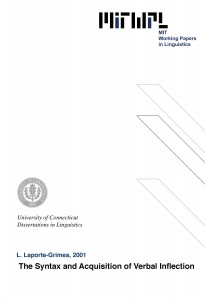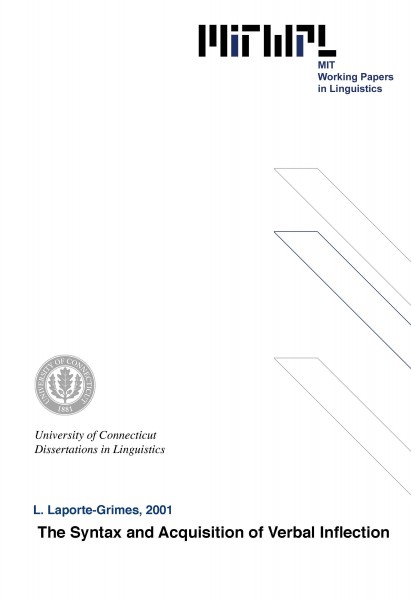The Syntax and Acquisition of Verbal Inflection
L. Laporte-Grimes, 2001
Abstract
This thesis presents an analysis of verbal inflection which takes the formal features of verbs as the mechanism which drives clausal structure. My analysis is based on a modification of Lasnik (1994) in order to account for a new type of English data which I call What About Answers. The resulting account entails that English clause structure has one inflectional node, which can be either an TAf or Agr. Cross-linguistically, languages can have universally allowed combinations of TAf, T+F and Agr.
In order for children to acquire the verbal morphology of their language, they must answer the following questions: Does my language have tense, Does my language have agreement, Is T affixal or featural in my language, For each verb class, is it lexically inflected or bare? I predict that children will answer the first two questions before the second two, and that they will not produce overt morphology without knowing the relevant syntactic features.
Further, children will determine all the relevant properties of a category before moving on to another. In order to empirically study these issues, I introduce a new methodology for studying childrens spontaneous production data: including detailed Contextual Information (CI) in transcript data. I demonstrate that this method allows us to identify the utterances relevant to these predictions, and in the resulting study, my predictions are borne out. This study also has implications for the study of Root Infinitives in English and cross-linguistically.
Table of Contents
1 Introduction 1
1.1. The Enterprise 1
1.2 Theoretical Importance of Verbal Inflection 1
1.3 Theoretical Claims 2
1.4 Methodological Issues 2
1.5 Organization of Dissertation 5
2 Syntax of Inflection 7
2.1 General Issues in the Study of Verbal Inflection 7
2.1.1 Data and Generalizations 7
2.1.2 Previous Analyses 9
2.1.3 Summary –Issues in the Study of Verbal Inflection 44
2.2 What About Answers (WAA) and the Study of Verbal Inflection 45
2.2.1 General Properties of What About Answers (WAA) 45
2.2.2 Lexically Bare Verbs and What About Answers (WAA) 48
2.2.3 Consequences for English Clause Structure: Agr or T 53
2.2.4 What About Answer (WAA): Subjects and Lexically Inflected Verbs 58
2.2.5 Evidence from French 65
2.2.6 Summary – WAA and the Study of Verbal Inflection 69
2.3 Universal Clause Structure 69
2.3.1 What is Universal? 69
2.3.2 Predicted Clause Structure 71
2.3.3 Evidence from Icelandic 76
2.3.3.1 Transitive Expletive Constructions (TEC) 76
2.3.3.2 Implications for English 81
2.3.4 Directions for Future Research 91
2.3.5 Summary – Predicted Range of Clause Structure 93
2.4 Summary – Syntax of Inflection 94
3. Acquisition of Inflection 96
3.1 Theoretical Predictions 97
3.1.1 Questions Child Must Answer 97
3.1.2 Defaults 99
3.1.3 Order of Acquisition 103
3.2 Expected Child Utterances 104
3.2.1 Assumptions 104
3.2.2 Structures and Predicted Utterances 106
3.2.2.1 Tense 106
3.2.2.2 Agreement 108
3.2.2.3 Tense and Agreement 112
3.2.2.4 Bare/Inflected Verb and Affixal/Featural T 115
3.2.3 Summary 115
3.3. Methodology 116
3.3.1 Spontaneous Production Data 116
3.3.2 The Study 120
3.3.2.1 Equipment 120
3.3.2.2 Session Duration, Frequency and Time Span 121
3.3.2.3 Session Location 123
3.3.2.4 Session Design 123
3.3.3 Speech Transcription 124
3.3.3.1 Phonological Information 124
3.3.3.2 Transcriber Training 125
3.3.4 Context Transcription 130
3.3.4.1 Context Included 131
3.3.4.2 Transcriber Training Method 137
3.3.5 Data Analysis 140
3.4 Results 145
3.4.1 Tense and Agreement 145
3.4.2 Agreement 150
3.4.3 Present Tense 158
3.4.3.1 Competence 158
3.4.3.2 Performance 163
3.4.4 Past Tense 171
3.4.5 Future Tense 178
3.4.6 Summary of Tense/Agreement Acquisition 179
3.4.7 Properties of T and Verb Classes 180
3.5 Reduced Clauses in Isolation: Desire and Causative-Progressive Interpretations 187
3.5.1 Desire 187
3.5.2 Causative-Progressive 194
3.5.3 Learnability 198
3.5.4 Root Infinitives 202
3.5.4.1 Competence Models 203
3.5.4.2 A Competence-Performance Model 208
3.5.4.3 Identification, Competence and Performance 211
3.5.5 Summary – The Acquisition of Inflection 217
4. Conclusion 220
5. Appendices 247
6. References 255

